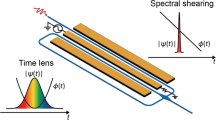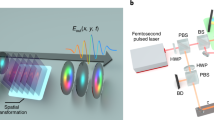Abstract
The ability to manipulate the spectral-temporal waveform of optical pulses has enabled a wide range of applications from ultrafast spectroscopy1 to high-speed communications2. Extending these concepts to quantum light has the potential to enable breakthroughs in optical quantum science and technology3,4,5. However, filtering and amplifying often employed in classical pulse shaping techniques are incompatible with non-classical light. Controlling the pulsed mode structure of quantum light requires efficient means to achieve deterministic, unitary manipulation that preserves fragile quantum coherences. Here, we demonstrate an electro-optic method for modifying the spectrum of non-classical light by employing a time lens6,7,8. In particular, we show highly efficient, wavelength-preserving, sixfold compression of single-photon spectral intensity bandwidth, enabling over a twofold increase of single-photon flux into a spectrally narrowband absorber. These results pave the way towards spectral-temporal photonic quantum information processing and facilitate interfacing of different physical platforms9,10,11 where quantum information can be stored12 or manipulated13.
This is a preview of subscription content, access via your institution
Access options
Subscribe to this journal
Receive 12 print issues and online access
$209.00 per year
only $17.42 per issue
Buy this article
- Purchase on Springer Link
- Instant access to full article PDF
Prices may be subject to local taxes which are calculated during checkout




Similar content being viewed by others
References
Cundiff, S. T. & Mukamel, S. Optical multidimensional coherent spectroscopy. Phys. Today 66, 44–49 (July, 2013).
Weiner, A. M. Ultrafast optical pulse shaping: a tutorial review. Opt. Commun. 284, 3669–3692 (2011).
Kielpinski, D., Corney, J. F. & Wiseman, H. M. Quantum optical waveform conversion. Phys. Rev. Lett. 106, 130501 (2011).
Roslund, J., de Araújo, R. M., Jiang, S., Fabre, C. & Treps, N. Wavelength-multiplexed quantum networks with ultrafast frequency combs. Nat. Photon. 8, 109–112 (2013).
Brecht, B., Reddy, D. V., Silberhorn, C. & Raymer, M. G. Photon temporal modes: a complete framework for quantum information science. Phys. Rev. X 5, 041017 (2015).
Kolner, B. H. Space-time duality and the theory of temporal imaging. IEEE J. Quant. Electron. 30, 1951–1963 (1994).
Foster, M. A. et al. Ultrafast waveform compression using a time-domain telescope. Nat. Photon. 3, 581–585 (2009).
Torres-Company, V., Lancis, J. & Andrés, P. Space-time analogies in optics. Prog. Opt. 56, 1–80 (2011).
Kimble, H. J. The quantum internet. Nature 453, 1023–1030 (2008).
Duan, L. M., Lukin, M. D., Cirac, J. I. & Zoller, P. Long-distance quantum communication with atomic ensembles and linear optics. Nature 414, 413–418 (2001).
Lavoie, J., Donohue, J. M., Wright, L. G., Fedrizzi, A. & Resch, K. J. Spectral compression of single photons. Nat. Photon. 7, 363–366 (2013).
Lvovsky, A. I., Sanders, B. C. & Tittel, W. Optical quantum memory. Nat. Photon. 3, 706–714 (2009).
Campbell, G. T. et al. Configurable unitary transformations and linear logic gates using quantum memories. Phys. Rev. Lett. 113, 063601 (2014).
Agrawal, G. P. Fiber-Optic Communication System (Wiley, 2010).
Mosley, P. et al. Heralded generation of ultrafast single photons in pure quantum states. Phys. Rev. Lett. 100, 133601 (2008).
Wasilewski, W., Kolenderski, P. & Frankowski, R. Spectral density matrix of a single photon measured. Phys. Rev. Lett. 99, 123601 (2007).
Huang, J. & Kumar, P. Observation of quantum frequency conversion. Phys. Rev. Lett. 68, 2153–2156 (1992).
McGuinness, H. J., Raymer, M. G., McKinstrie, C. J. & Radic, S. Quantum frequency translation of single-photon states in a photonic crystal fiber. Phys. Rev. Lett. 105, 093604 (2010).
Zaske, S. et al. Visible-to-telecom quantum frequency conversion of light from a single quantum emitter. Phys. Rev. Lett. 109, 147404 (2012).
Ates, S. et al. Two-photon interference using background-free quantum frequency conversion of single photons emitted by an InAs quantum dot. Phys. Rev. Lett. 109, 147405 (2012).
Vollmer, C. E. et al. Quantum up-conversion of squeezed vacuum states from 1550 to 532 nm. Phys. Rev. Lett. 112, 073602 (2014).
Matsuda, N. Deterministic reshaping of single-photon spectra using cross-phase modulation. Sci. Adv. 2, e1501223 (2016).
Jensen, K. et al. Quantum memory for entangled continuous-variable states. Nat. Phys. 7, 13–16 (2011).
Bustard, P. J., Lausten, R., England, D. G. & Sussman, B. J. Toward quantum processing in molecules: a THz-bandwidth coherent memory for light. Phys. Rev. Lett. 111, 083901 (2013).
Kang, I., Dorrer, C. & Quochi, F. Implementation of electro-optic spectral shearing interferometry for ultrashort pulse characterization. Opt. Lett. 28, 2264–2266 (2003).
Davis, A. O. C., Saulnier, P. M., Karpiński, M. & Smith, B. J. Pulsed single-photon spectrograph by frequency-to-time mapping using chirped fiber Bragg gratings. Preprint at http://arXiv.org/abs/1610.03040 (2016).
Morizur, J.-F. et al. Programmable unitary spatial mode manipulation. J. Opt. Soc. Am. A 27, 2524–2531 (2010).
Olislager, L. et al. Creating and manipulating entangled optical qubits in the frequency domain. Phys. Rev. A 89, 052323 (2014).
Lukens, J. M., Odele, O. D., Leaird, D. E. & Weiner, A. M. Electro-optic modulation for high-speed characterization of entangled photon pairs. Opt. Lett. 40, 5331–5334 (2015).
Wang, J. et al. Reconfigurable radio-frequency arbitrary waveforms synthesized in a silicon photonic chip. Nat. Commun. 6, 5957 (2015).
Avenhaus, M., Eckstein, A., Mosley, P. J. & Silberhorn, C. Fiber-assisted single-photon spectrograph. Opt. Lett. 34, 2873–2875 (2009).
Acknowledgements
We acknowledge insightful comments and discussion about the work with K. Banaszek, C. Becher, A. O. C. Davis, E. Figueroa, D. Gauthier, X. Ma, C. Silberhorn, V. Torres-Company, N. Treps and I. A. Walmsley. This project has received funding from the European Community (EC) Horizon 2020 research and innovation programme under grant agreement no. 665148. M.K. was partially supported by a Marie Curie Intra-European Fellowship no. 301032 within the EC 7th Framework Programme and by the National Science Centre of Poland project no. 2014/15/D/ST2/02385. M.J. was supported by the PhoQuS@UW project within the EC 7th Framework Programme (grant agreement no. 316244).
Author information
Authors and Affiliations
Contributions
M.K. and B.J.S. conceived the project. M.K. and M.J. designed and performed the experiment. M.J. analysed the data with input from M.K. L.J.W. developed the RF phase-locking system and contributed to the early stages of the experiment. M.K., M.J. and B.J.S. wrote the manuscript. M.J. prepared the figures.
Corresponding author
Ethics declarations
Competing interests
The authors declare no competing financial interests.
Supplementary information
Supplementary information
Supplementary information (PDF 363 kb)
Rights and permissions
About this article
Cite this article
Karpiński, M., Jachura, M., Wright, L. et al. Bandwidth manipulation of quantum light by an electro-optic time lens. Nature Photon 11, 53–57 (2017). https://doi.org/10.1038/nphoton.2016.228
Received:
Accepted:
Published:
Issue Date:
DOI: https://doi.org/10.1038/nphoton.2016.228
This article is cited by
-
Fresnel time lens empowers quantum networks
Nature Photonics (2023)
-
Experimental realisations of the fractional Schrödinger equation in the temporal domain
Nature Communications (2023)
-
Interface between picosecond and nanosecond quantum light pulses
Nature Photonics (2023)
-
Frequency-insensitive spatiotemporal shaping of single photon in multiuser quantum network
npj Quantum Information (2023)
-
A note on “Variable-focus liquid lens based on electrically responsive fluid”
Journal of Optics (2023)



